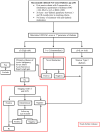Model to Determine Risk of Pancreatic Cancer in Patients With New-Onset Diabetes
- PMID: 29775599
- PMCID: PMC6120785
- DOI: 10.1053/j.gastro.2018.05.023
Model to Determine Risk of Pancreatic Cancer in Patients With New-Onset Diabetes
Abstract
Background & aims: Of patients with new-onset diabetes (NOD; based on glycemic status) older than 50 years, approximately 1% are diagnosed with pancreatic cancer (PC) within 3 years. We aimed to develop and validate a model to determine risk of PC in patients with NOD.
Methods: We retrospectively collected data from 4 independent and nonoverlapping cohorts of patients (N = 1,561) with NOD (based on glycemic status; data collected at date of diagnosis and 12 months previously) in the Rochester Epidemiology Project from January 1, 2000 through December 31, 2015 to create our model. The model weighed scores for 3 factors identified in the discovery cohort to be most strongly associated with PC (64 patients with PC and 192 with type 2 diabetes): change in weight, change in blood glucose, and age at onset of diabetes. We called our model Enriching New-Onset Diabetes for Pancreatic Cancer (ENDPAC). We validated the locked-down model and cutoff score in an independent population-based cohort of 1,096 patients with diabetes; of these, 9 patients (82%) had PC within 3 years of meeting the criteria for NOD.
Results: In the discovery cohort, the END-PAC model identified patients who developed PC within 3 years of diabetes onset (area under receiver operating characteristic curve 0.87); a score of at least 3 identified patients who developed PC with 80% sensitivity and specificity. In the validation cohort, a score of at least 3 identified 7 of 9 patients with PC (78%) with 85% specificity; the prevalence of PC in patients with a score of at least 3 (3.6%) was 4.4-fold greater than in patients with NOD. A high END-PAC score in patients who did not have PC (false positives) was often due to such factors as recent steroid use or different malignancy. An ENDPAC score no higher than 0 (in 49% of patients) meant that patients had an extremely low risk for PC. An END-PAC score of at least 3 identified 75% of patients in the discovery cohort more than 6 months before a diagnosis of PC.
Conclusions: Based on change in weight, change in blood glucose, and age at onset of diabetes, we developed and validated a model to determine risk of PC in patients with NOD based on glycemic status (END-PAC model). An independent prospective study is needed to further validate this model, which could contribute to early detection of PC.
Keywords: Biomarker; Enriching New-Onset Diabetes for Pancreatic Cancer; Pancreas; Screening.
Copyright © 2018 AGA Institute. Published by Elsevier Inc. All rights reserved.
Conflict of interest statement
Figures




References
-
- Rahib L, Smith BD, Aizenberg R, et al. Projecting cancer incidence and deaths to 2030: the unexpected burden of thyroid, liver, and pancreas cancers in the United States. Cancer research. 2014;74:2913–2921. - PubMed
-
- SEER. [Accessed on January 17, 2018];Fast Facts: Pancreatic Cancer. Available at: http://seer.cancer.gov/statfacts/html/pancreas.html.
-
- Ogawa Y, Tanaka M, Inoue K, et al. A prospective pancreatographic study of the prevalence of pancreatic carcinoma in patients with diabetes mellitus. Cancer. 2002;94:2344–9. - PubMed
Publication types
MeSH terms
Substances
Grants and funding
LinkOut - more resources
Full Text Sources
Other Literature Sources
Medical

